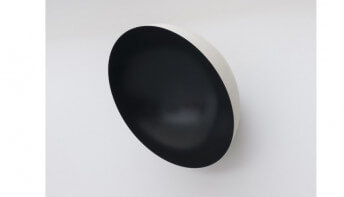The Week in Abstract Art – Our Universally Subjective World
Jan 5, 2017
It is easy to forget how differently each of us experiences the world. It is in our nature to seek conclusions, to make definitive statements. We want something to be true for everyone. But we are endlessly baffled by just how subjective life is. Abstract artists often attempt to simplify, to strip away subjectivities, to address only what is essential in order to arrive at something that might be universal, or to express a collective truth. In his recent book Reductionism in Art and Brain Science, Nobel Prize winning neuroscientist Eric Kandel illustrates a parallel between the quest of abstract artists to express universalities and the way scientists simplify problems to make them easier to solve. “This is reductionism,” Kandel writes, “to take a complex problem and select a central, but limited, component that you can study in depth.” Kandel believes that to simplify in order to arrive at something true is an essential element of the human thought process, and that abstract art can teach us to do it better. This week we highlight five current abstract art exhibitions featuring work from various different cultures, examining how they have each subjectively reduced in order to express the universal elements of our world.
Alex Janvier, Modern Indigenous Master, National Gallery of Canada, Ottawa
On view through 17 April 2017
Abstract masters like Wassily Kandinsky and Paul Klee served as early inspirations for Canadian aboriginal artist Alex Janvier. Since the 1960s, Janvier has been honing his distinct style, incorporating lyrical gestures, a vivid color palette, and a mixture of symbolic figuration and total abstraction in order to express the universalities of his ancestral traditions.
 Alex Janvier - Lubicon, 1988, acrylic on canvas, 165.2 × 267 cm
Alex Janvier - Lubicon, 1988, acrylic on canvas, 165.2 × 267 cm
The Advent of Abstraction: Russia, 1914-1923, National Gallery of Canada, Ottawa
On view through 12 March 2017
Also on view at the National Gallery of Canada is this extensive exhibition of Russian abstract art, featuring reductive abstract works by post World War I Suprematist and Constructivist artists. The focus of the exhibition is to highlight rare paintings that were nearly lost in the years following the Russian Revolution, giving special attention to the painting Proun 8 Positions, by El Lissitsky, a protégée of Kazimir Malevich.
 El Lissitsky - Proun 8 Positions, 1923, Oil and gouache with metal foil on canvas
El Lissitsky - Proun 8 Positions, 1923, Oil and gouache with metal foil on canvas
Pedro de Oraá: Abstractivos, National Museum of Fine Arts in Havana, Cuba
Closing date unavailable
Winner of the 2015 National Prize of Plastic Arts in Cuba, Pedro de Oraá has been a leading figure in Cuban abstract and concrete art since the 1950s. Barely recognized by officials in his own country or art viewers internationally, he is finally being acknowledged for his unique and influential contributions. This solo exhibition features 30 new and recent works.
 Pedro de Oraa - Contrarios complementarios (series), 2015, Acrylic on canvas, 59 x 59 in
Pedro de Oraa - Contrarios complementarios (series), 2015, Acrylic on canvas, 59 x 59 in
Postwar: Art Between the Pacific and the Atlantic, 1945-1965, Haus der Kunst, Munich
On view through 26 March 2017
In eight sections this exhibition offers an in depth look at the various ways cultures across the globe responded aesthetically to the aftermath of World War II. Three sections in particular—Concrete Visions, Nations Seeking Form, and Form Matters—focus on international reductive abstract trends, tracking them as they occurred simultaneously yet independently on multiple continents.
 Hélio Oiticica - Metaesquema, 1955
Hélio Oiticica - Metaesquema, 1955
Chung Chang-Sup, Axel Vervoordt Gallery, Antwerp
On view through 28 January 2017
Dansaekhwa is a Korean abstract art movement that emerged in the 1970s. It was devoted to reviving the ancient symbiosis of humanity, nature and materiality. Chung Chang-Sup was a prominent participant in the movement, and until his death in 2011 he continued to explore the essence and meaning of his reductive aesthetic habits. This solo exhibition focuses on the works Chung Chang-Sup made out of handmade paper for the final forty years of his life.
 Chung Chang-Sup - Axel Vervoordt Gallery, Antwerp, Installation view
Chung Chang-Sup - Axel Vervoordt Gallery, Antwerp, Installation view
Featured image: Alex Janvier - Untitled, 1986, acrylic on canvas, 165.1 × 266.7 cm
All images used for illustrative purposes only
By Phillip Barcio





